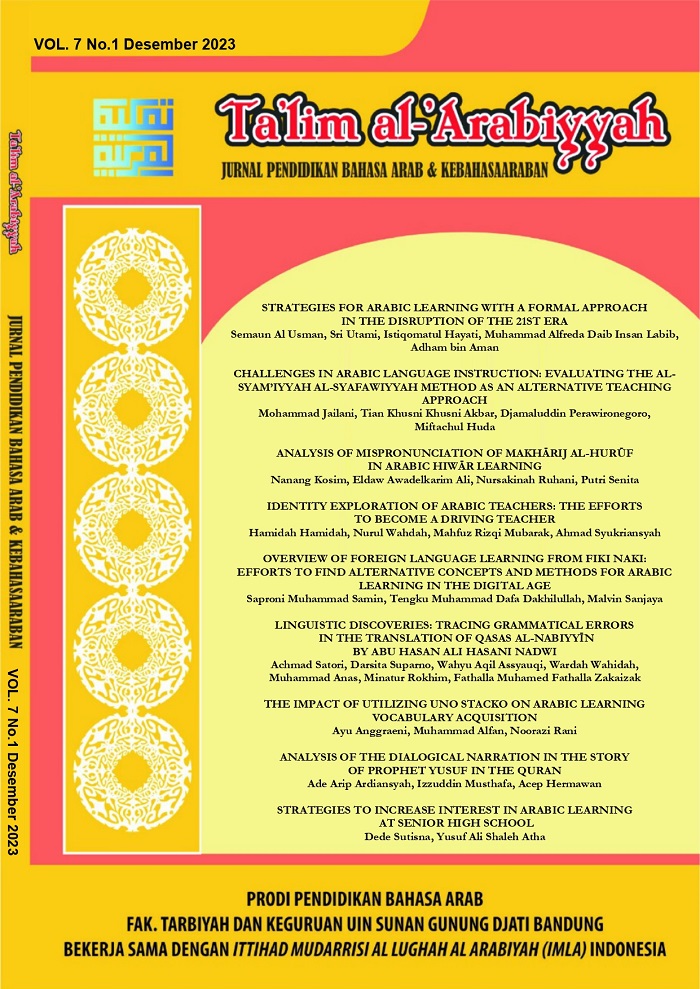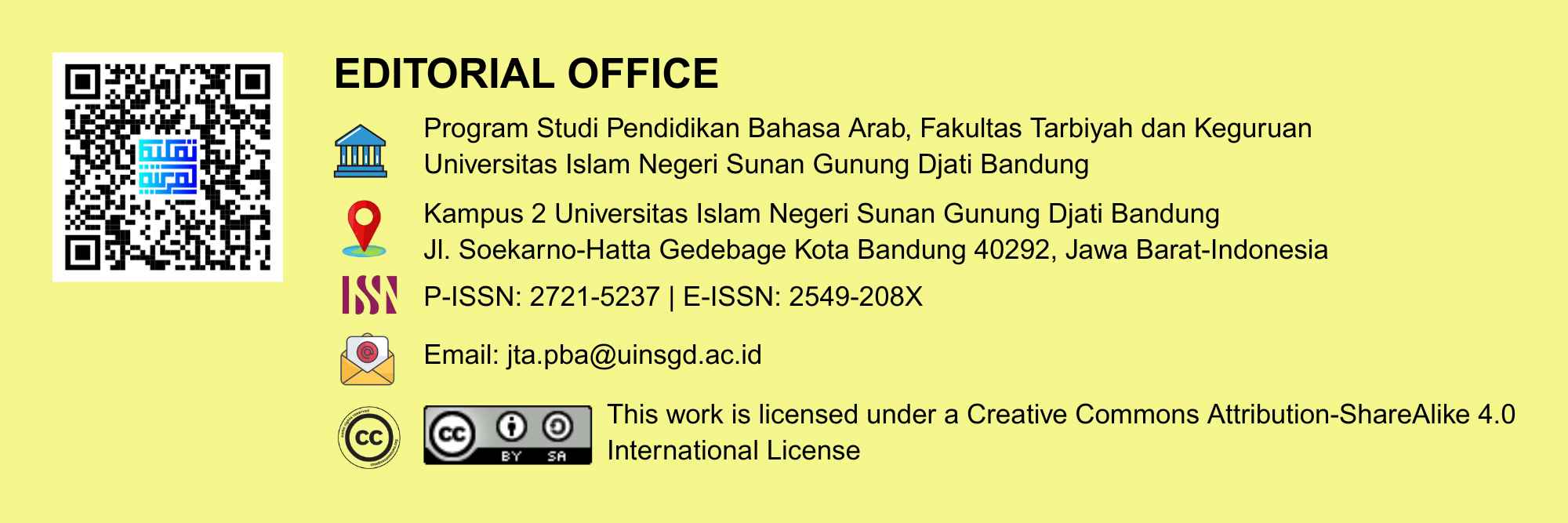Linguistic Discoveries: Tracing Grammatical Errors in the Translation of Qasas Al-Nabiyyīn by Abu Hasan Ali Hasani Nadwi
DOI:
https://doi.org/10.15575/jpba.v7i2.26666Keywords:
Abu Hasan Ali Hasani Nadwi, Grammatical errors, Linguistic analysis, Translation critiqueAbstract
This article aims to understand the grammatical errors in the translated text of "QasasAl-Nabiyyīn" by Abu Hasan Ali Hasani Nadwi. This research uses the descriptivequalitative method to identify morphological and syntactic errors in the translated text.Data collection was done by collecting the original text of the source language and itstranslation in the book "Qasas Al-Nabiyyīn." The data collection steps involvedidentifying pairs of both languages for grammatical analysis, followed by data analysisto identify grammatical errors. The analysis results showed 18 grammatical errors in thetranslation of the book, consisting of 7 morphological errors and 11 syntactic errors.These errors impact the incompatibility of the message contained in the source text. Inorder to correct the grammatical errors, a correction analysis was conducted on thetarget language, especially in Indonesian, by referring to the applicable grammaticalrules. This article concludes that correcting grammatical errors can improve theaccuracy and clarity of the message in the translation of "Qasas Al- Nabiyyīn" so that itcan be more effectively conveyed to readers who speak the target language. Thisanalysis contributes to a practical understanding of the importance of paying attentionto grammatical aspects in translating religious texts. Recommendations for futureresearch include developing more effective translation strategies involving source andtarget language experts. Research can expand the scope of analysis to explore semanticand pragmatic aspects of translated texts.
References
Akmal, M. F., & Suparno, D. (2022). Meninjau Istilah Kedokteran dalam Bahasa Arab Secara Harfiah. Nady Al-Adab: Jurnal Bahasa Arab, 19(1), 66–80. https://doi.org/10.20956/jna.v19i1.19591
Aloudah, N. M. (2022). Qualitative research in the Arabic language. When Should Translations to English occur? A literature review. Exploratory Research in Clinical and Social Pharmacy, 6(1), 100153. https://doi.org/10.1016/j.rcsop.2022.100153
An Nadwi, A. A. al-Banjari. (2000). Al-ʻAlim al-ʻAllaamah Samahatus Syaikh As-Sayyid Abul Hasan Ali al-Hasani an-Nadwi rahimahullahu taʻala: Sejarah hidup dan pemikirannya. Khazanah Banjariah.
Arifianto, M. L., Kholisin, K., Ridwan, N. A., Izzudin, I. F., Mujahidah, Z. A., & Muhtar, S. N. (2022). Designing Research Result-Based Arabic Pragmatic Learning Module On Politeness Principles And Strategies. Ta’lim al-’Arabiyyah: Jurnal Pendidikan Bahasa Arab & Kebahasaaraban, 6(2), 134–154. https://doi.org/10.15575/jpba.v6i2.20235
Bekker, S., & Clark, A. M. (2018). Improving Qualitative Research Findings Presentations: Insights From Genre Theory. International Journal of Qualitative Methods, 17(1), 160940691878633. https://doi.org/10.1177/1609406918786335
Bewersdorff, A., Sebler, K., Baur, A., Kasneci, E., & Nerdel, C. (2023). Assessing Student Errors in Experimentation Using Artificial Intelligence and Large Language Models: A Comparative Study with Human Raters. Computers and Education: Artificial Intelligence, 5(1), 100177. https://doi.org/10.1016/j.caeai.2023.100177
Binti Jasni, N. S., & Ardiansyah, A. A. (2020). Arabic Learning Based On E-Learning Using Arabic Teacher Website In The Pandemic Era Of Covid-19. Ta’lim al-’Arabiyyah: Jurnal Pendidikan Bahasa Arab & Kebahasaaraban, 4(2), 122–137. https://doi.org/10.15575/jpba.v4i2.8601
Bustomi, J., & Hudaya, U. (2018). Bentuk dan Jabatan Dalam Struktur Kalimat Bahasa Arab dan Bahasa Indonesia. Ta’lim al-’Arabiyyah: Jurnal Pendidikan Bahasa Arab & Kebahasaaraban, 2(1), 1–21. https://doi.org/10.15575/jpba.v2i1.9544
Chaer, A. (2009). Sintaksis Bahasa Indonesia (Pendekatan Proses) (Pertama). Rineka Cipta.
Cornips, L., Van Koppen, M., Leufkens, S., Melum Eide, K., & Van Zijverden, R. (2023). A Linguistic-Pragmatic Analysis of Cat-Induced Deixis in Cat-Human Interactions. Journal of Pragmatics, 217(1), 52–68. https://doi.org/10.1016/j.pragma.2023.09.002
Creswell, J. W. (2015). Research Design Qualitative Quantitative and Mixed Methods Approaches. In The British Journal of Psychiatry (First Edti, Vol. 111, Issue 479). Sage. https://doi.org/10.1192/bjp.111.479.1009-a
Dania, F. R., Nurhuda, Z., Suparno, D., Abshar, U., Satori, A., & Nisa’, M. (2023). Pengenalan Identitas Budaya Betawi Melalui Adaptasi Cerita Anak Narada Karya Kamil Kailani. Al Mi’yar: Jurnal Ilmiah Pembelajaran Bahasa Arab Dan Kebahasaaraban, 6(2), 343–364. https://doi.org/10.35931/am.v6i2.2108
Dzakiruddin, M., & Junaedi, J. (2022). Kesalahan Berbahasa: Sebuah Analisis dan Implementasi dalam Penelitian Bahasa Arab. EL-IBTIKAR: Jurnal Pendidikan Bahasa Arab, 11(1), 1–13. https://doi.org/10.24235/ibtikar.v11i1.9786
El Mallah, F. (2022). The Influence of Translators’ Cultural Backgrounds on their Performance: Translation of the Quran as a Case-study. International Journal of Linguistics, Literature and Translation, 5(8), 70–82. https://doi.org/10.32996/ijllt.2022.5.8.9
Flores, A. Z., Montag, J. L., & Willits, J. A. (2023). Using Known Words to Learn More Words: A Distributional Model of Child Vocabulary Acquisition. Journal of Memory and Language, 132(1), 104446. https://doi.org/10.1016/j.jml.2023.104446
Hasanah, A., & Al-Rasyid, H. (2023). Analisis Isi Buku Nahwu Titik Nol terhadap Peningkatan Minat Belajar Santri Manhalun Nabighin Medan. Journal of Education Research, 4(3), 1272–1279. https://doi.org/10.37985/jer.v4i3.385
Hermawan, A. (2018). Diaglosa bahasa Arab (Dilema Penggunaan Dialek Fuá¹£á¸¥Ä dan ‘Ᾱmmiyah). Ta’lim al-’Arabiyyah: Jurnal Pendidikan Bahasa Arab & Kebahasaaraban, 2(2), 141–152. https://doi.org/10.15575/jpba.v2i2.9531
Hidayat, R. N. (2020). Annexation Structure (Frasa Idhafah dalam Buku Al-Qira’ah Ar-Sasyidah Juz Pertama Karya Abu Al-Hasan ’Ali Al-Hasani Al-Nadwi: Analisis Semantik Gramatikal [Skripsi, Universitas Sebelas Maret]. Retrieved from https://digilib.uns.ac.id/dokumen/detail/81767/Annexation-Structure-Frasa-Idhafah-dalam-Buku-Al-Qiraah-Ar-Rasyidah-Juz-Pertama-Karya-Abu-Al-Hasan-Ali-Al-Hasani-Al-Nadwi-Analisis-Semantik-Gramatikal
Jumriyah, J., & Rusuly, U. (2021). Pengembangan Materi Berbasis Komunikasi Bilingual Bagi Civitas Akademika UIN Maulana Malik Ibrahim Malang. Ta’lim al-’Arabiyyah: Jurnal Pendidikan Bahasa Arab & Kebahasaaraban, 5(2), 140–154. https://doi.org/10.15575/jpba.v5i2.13880
Kamil, R. I., Irhamni, I., & Murtadho, N. (2018). Kesalahan Gramatikal dan Penerjemahan Literal Buku Durusun Iqtishadiyatun Min Ramadlan. Bahasa Dan Seni : Jurnal Bahasa, Sastra, Seni, Dan Pengajarannya, 46(1), 82–95. https://doi.org/10.17977/um015v46i12018p082
Kumara, A., Virnanda, A., Azmi, L. S., & Auliani, R. R. (2020). Implementasi Ilmu Pengetahuan dalam Perspektif Al-Qur’an sebagai Upaya Menghadapi Tantangan Zaman. Al-Afkar, Journal For Islamic Studies, 3(2), 111–127. https://doi.org/10.31943/afkar_journal.v3i2.113
Leavy, P. (2022). Research Design: Quantitative, Qualitative, Mixed Methods, Arts-Based, and Community-Based Participatory Research Approaches. Guilford Publications.
Moeliono, A. M., Lapoliwa, H., & Alwi, H. (2017). Tata Bahasa Baku Bahasa Indonesia. Badan Pengembangan dan Pembinaan Bahasa Kementerian Pendidikan dan Kebudayaan.
Mohammed Saleh Al-Hamzi, A., Sumarlam, S., Santosa, R., & Jamal, M. (2023). A Pragmatic and Discourse Study of Common Deixis Used by Yemeni-Arab Preachers in Friday Islamic Sermons at Yemeni Mosques. Cogent Arts & Humanities, 10(1), 2177241. https://doi.org/10.1080/23311983.2023.2177241
Mulyadi, M. (2021). Integration of Character Education and Tazkiyah al-Nafs: Perspective of Abū Hasan al-Nadwī. ADDIN, 15(2), 303–330. https://doi.org/10.21043/addin.v15i2.14509
Nasir, M. S., & Mat Teh, K. S. (2021). Elemen Nilai Dalam Teks Sastera Kisah Para Nabi Untuk Bacaan Kanak-kanak Menurut Perspektif al-Nadwi: Elements of Value in Literary Text of the Prophets’ Stories for Children’s Reading from al-Nadwi’s Perspectives. International Journal of Language Education and Applied Linguistics, 11(1), 14–26. https://doi.org/10.15282/ijleal.v11.6116
Rosaria, S. D. (2020). Kesalahan Gramatikal Pada Teks Terjemahan Abstrak (Indonesia-Inggris) Mahasiswa Universitas Semarang (USM). Jurnal Dinamika Sosial Budaya, 22(1), 54–64. https://doi.org/10.26623/jdsb.v22i1.2111
Ruslan, R. F., Muin, N., & Puspitasari, A. (2023). Analisis Kesalahan Berbahasa Dalam Interaksi Pembelajaran Bahasa Indonesia pada Siswa Kelas X MIPA 1 SMAN 1 Bantaeng. Journal on Education, 6(1), 7582–7588. https://doi.org/10.31004/joe.v6i1.4068
Saputra, A., Agustina, A., & Juita, N. (2018). Kata Penyukat Dalam Bahasa Minangkabau Di Nagari Sungai Geringging Kabupaten Padang Pariaman. Jurnal Bahasa Dan Sastra, 6(2), 195-204. https://doi.org/10.24036/81023080
Sugiyono. (2018). Metode Penelitian Kombinasi (Mix Methods). Alfabeta.
Suparno, D. (2012). Komposisi Bahasa Indonesia (Zubair, Ed.). Adabia Press.
Syafei, I., Ardiansyah, A. A., & Nafsi, Z. (2020). Analisis Kontrastif Proses Afiksasi Pada Verba dalam Bahasa Arab dan Bahasa Minangkabau. Metalingua: Jurnal Penelitian Bahasa, 18(2), 225–237. Retrieved from http://metalingua.kemdikbud.go.id/jurnal/index.php/metalingua/article/view/480
Downloads
Published
How to Cite
Issue
Section
Citation Check
License
Copyright (c) 2023 Achmad Satori, Darsita Suparno, Wahyu Aqil Assyauqi, Wardah Wahidah, Muhammad Anas, Minatur Rokhim, Fathalla Muhamed Fathalla Zakaizak

This work is licensed under a Creative Commons Attribution-ShareAlike 4.0 International License.
Authors who publish in Ta'lim al-'Arabiyyah: Jurnal Pendidikan Bahasa Arab dan Kebahasaaraban agree to the following terms:
- Authors retain copyright and grant the journal right of first publication with the work simultaneously licensed under a Creative Commons Attribution-ShareAlike 4.0 International (CC BY-SA 4.0) License that allows others to share the work with an acknowledgment of the work's authorship and initial publication in this journal.
- Authors are able to enter into separate, additional contractual arrangements for the non-exclusive distribution of the journal's published version of the work (e.g., post it to an institutional repository or publish it in a book), with an acknowledgment of its initial publication in this journal.
- Authors are permitted and encouraged to post their work online (e.g., in institutional repositories or on their website) prior to and during the submission process, as it can lead to productive exchanges, as well as earlier and greater citation of published work (See The Effect of Open Access).
![]()
Ta'lim al-'Arabiyyah: Jurnal Pendidikan Bahasa Arab dan Kebahasaaraban is licensed under a Creative Commons Attribution-ShareAlike 4.0 International License.
Based on a work at https://journal.uinsgd.ac.id/index.php/Talim








